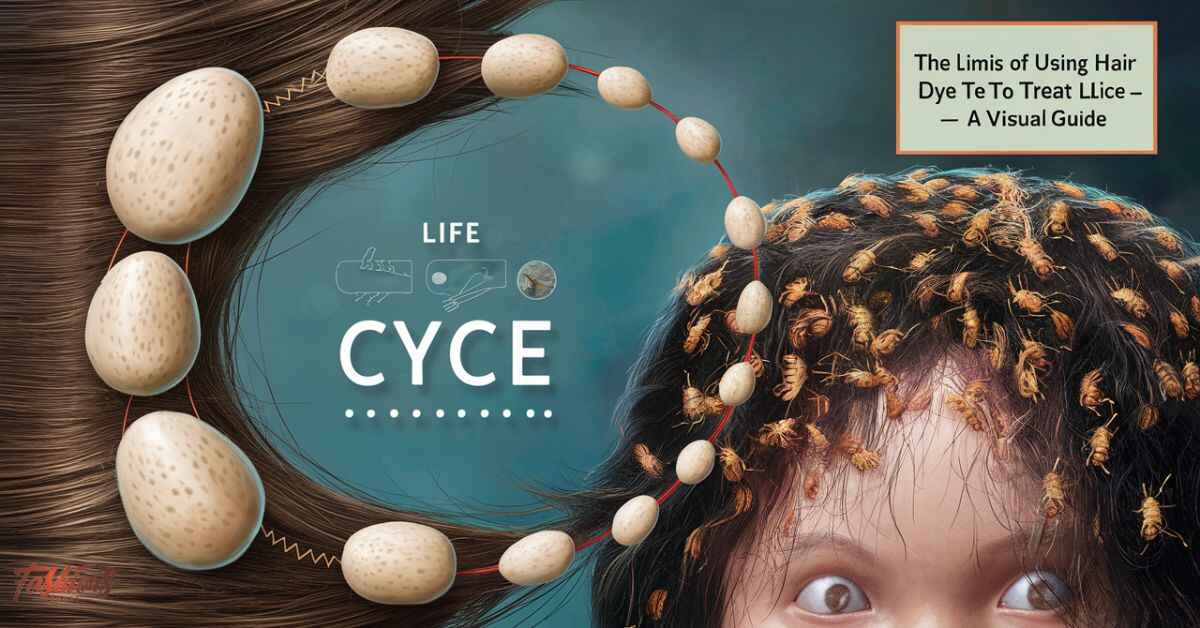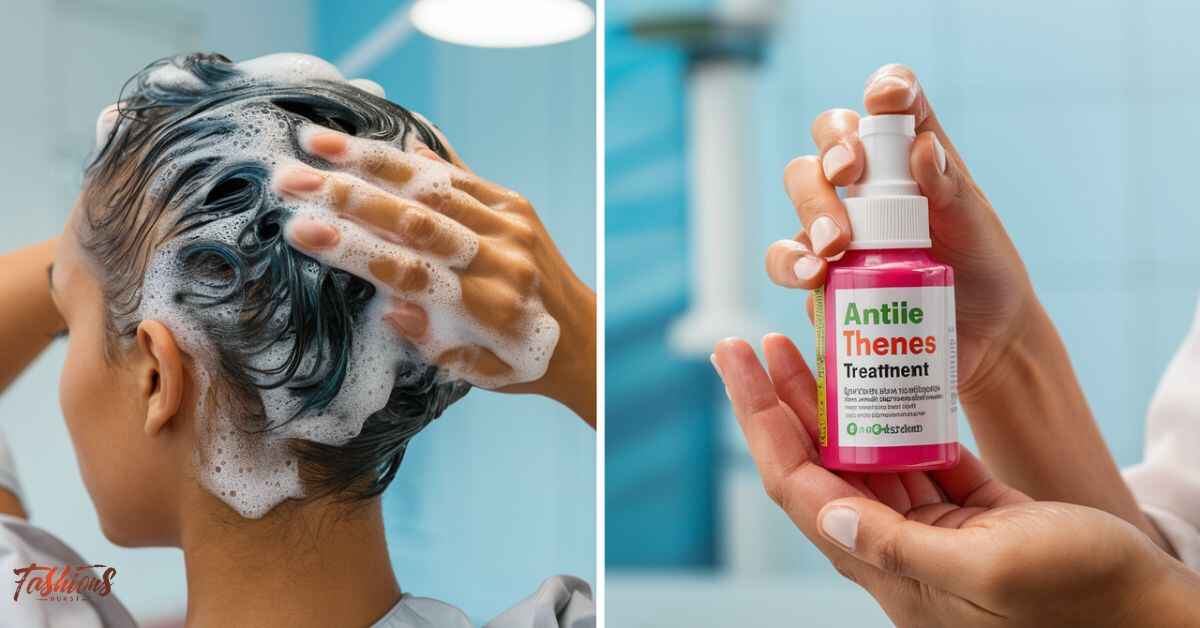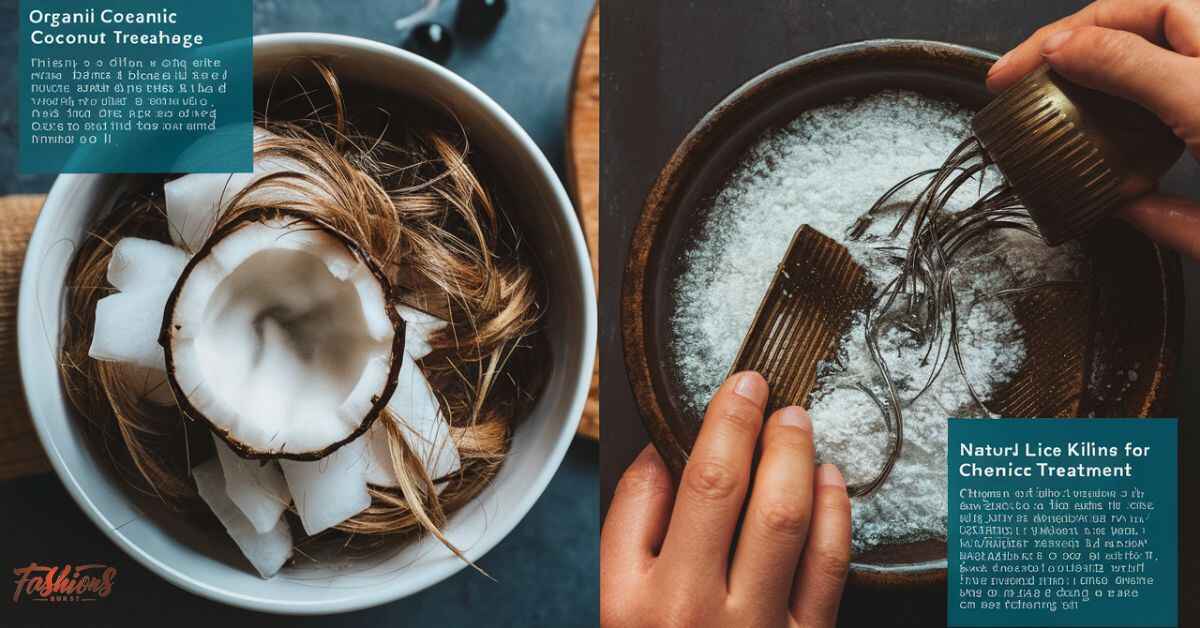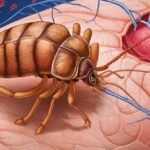Dealing with a lice infestation, especially as a parent of school-age children, can be an absolute nightmare. You feel itchy just thinking about those tiny bugs crawling around on your kids’ scalps.
So when you hear rumors that hair dye might kill lice, it can seem like a miracle solution. But does this supposed home remedy really work? While anecdotal evidence claims hair dye can kill live lice, scientific research shows it’s an ineffective and risky treatment that doesn’t eliminate nits/lice eggs.
The Icky Reality of Head Lice
Before we dive into hair dye’s potential as a lice killer, let’s cover some basic facts about head lice themselves. These pesty little parasites are tiny, wingless insects that live and feed on human blood from the scalp. Their life cycle involves laying nits (lice eggs) which hatch into more lice after 7-10 days.
Head lice spread extremely easily through direct head-to-head contact and by sharing personal items like hats, scarves, brushes, etc. They are most common among school-aged children, with an estimated 6-12 million kids ages 3-11 getting infested each year in the United States alone!
As any parent who has dealt with lice can attest, discovering your child has an active infestation induces instant panic. The itching, the scramble to disinfect everything, the wrestling matches to comb out nits – it’s a stressful, miserable experience. So the prospect of an easy treatment like hair dye can be highly tempting.
Read this blog: How Much Are Hair Extensions?
The Theories Behind Using Hair Dye for Lice
The idea behind using hair dye as a lice treatment stems from two key ingredients found in many permanent dyes:
- Ammonia– This alkaline chemical produces irritating fumes that may be toxic to lice and disrupt their metabolism.
- Hydrogen Peroxide– Studies show this oxidizing agent can be effective against other parasite species like sea lice.
Some believe that when the dye’s ammonia and peroxide penetrate the lice’s exoskeleton, it kills them off. Anecdotal reports from people who used hair dye for lice seem to support this.
The Limits of Using Hair Dye to Treat Lice
Here’s the catch – while hair dye may potentially kill some live lice crawling on your scalp, it does NOTHING to eliminate lice eggs/nits. The dye is unable to penetrate the hard nit casings attaching them to your hair strands.
This means any nits left behind after the dye application will eventually hatch, reintroducing live lice in 7-10 days and causing a recurring infestation. Lice can live up to 30 days on the human host, continuing to lay 3-5 nits per day during that time.
So at best, using hair dye gives you temporary relief from live lice until new ones hatch from any remaining fertile nits. Thorough nit removal by combing and picking is still absolutely necessary.
The Proper Way to Use Hair Dye for Lice (If You Must)
If you’re set on trying the hair dye approach despite its limitations, here are the steps most recommended:
- Prepare for Dye Application
- Start by saturating hair with a 50/50 vinegar and water solution, letting it soak for 5-15 minutes. This may help dislodge some nits.
- Rinse out the vinegar and comb through with a lice comb to remove as many nits/lice as possible beforehand.
- Apply the Hair Dye
- Mix dye in a well-ventilated area according to package instructions. Permanent ammonia-based dyes are preferred.
- Saturate your entire scalp, behind ears, nape of neck, and coat hair from roots to ends with the dye mixture.
- Process and Rinse Out Dye
- Leave dye on for the full recommended processing time.
- Rinse out thoroughly until water runs completely clear.
- Comb Out Any Remaining Lice/Nits
- Once hair is rinsed, comb through again section-by-section with a clean lice comb, disposed of properly after use.
- Consider blow drying hair on highest heat setting as heat may help kill any residual lice.
- Repeat Process Weekly Until Fully Clear
- You’ll likely need to repeat the full dyeing, combing, nit-picking process weekly for a few weeks to eradicate any newly hatched lice.
“I tried the hair dye treatment after all the OTC lice shampoos failed. I’m not sure if it killed them all, but I could definitely see tons of dead lice on my kids’ hair after I rinsed it out. Still had to keep combing like crazy though!” – Karen M., Oklahoma City
Even with diligent dyeing and nit combing, you may miss a few fertile lice eggs leading to reinfestation down the line. Consistency is key with this treatment method.
Also read: Achieving Dansby Swanson’s Hairstyle: Step-By-Step Tutorial
Cautions About Using Hair Dye for Lice
Beyond the effectiveness issues, using hair dye to treat lice carries some legitimate safety risks:
Skin/Scalp Irritation
- Ammonia, peroxide, and other dye chemicals can seriously irritate and burn sensitive scalp areas.
- Potential side effects include redness, itching, hives, swelling, and hair damage/breakage.
Chemical Exposure Dangers
- Accidentally ingesting hair dye can cause mouth/throat burns, vomiting, and toxic poisoning.
- The fumes are also hazardous to inhale, especially in enclosed areas, potentially causing respiratory distress.
- Any dye exposure to eyes raises the risk of severe irritation or even vision impairment.
Increased Risks for Children
- Pediatric medical experts overwhelmingly advise AGAINST using hair dye for lice on kids.
- Children have thinner, more delicate hair and scalps highly susceptible to chemical damage.
- They also face higher risks of accidentally ingesting dye or getting it in their eyes/airways.
Even for adult applications, extreme caution must be taken when handling hair dyes to avoid unintended exposure. Protective gloves, proper ventilation, and keeping the product completely away from the face is crucial.
Safer and More Effective Lice Treatments
Rather than resorting to a harsh, iffy remedy like hair dye, there are standard and natural lice treatments that are safer and more effective:
Over-the-Counter Medicated Lice Shampoos
- Products like Nix, Pronto, and Rid contain permethrin or pyrethrin pesticides to kill live lice.
- Require a second treatment 7-10 days later to kill any newly hatched lice from missed eggs.
- Resistance to certain OTC pesticides has been increasing, reducing their effectiveness.
Prescription Lice Treatments
- Medications like malathion (Ovide) lotion, spinosad (Natroba) suspension, or ivermectin (Sklice) are available by prescription.
- These prescription lice products kill live lice through novel neurotoxic or insecticidal modes.
- Can have their own side effects and aren’t 100% ovicidal against nits.
Natural Home Remedies
- Smothering lice by saturating hair with oils like olive, coconut, or petroleum jelly for 8+ hours.
- Using enzyme-based “desiccants” to dehydrate and kill lice through ingredients like sodium chloride.
- These natural approaches are non-toxic but require extensive combing and re-treatments.
Professional Lice Removal Services
- Companies like Lice Doctors offer in-home professional lice removal and treatment.
- Use thorough heated air, combing, and non-toxic enzymatic treatments to kill all bugs and nits.
- Safe, effective, but can be quite costly compared to DIY treatments.
No matter which lice treatment route you choose, physically removing all nits from hair strands using a fine-toothed lice comb or professional combing service is critical to breaking the life cycle. Leaving even a few viable nits behind allows the infestation to persist.
Can Dyed Hair Prevent Future Lice Infestations?
Some people operate under the misconception that dyeing or bleaching hair will prevent future lice infestations. Unfortunately, this is simply not true. Lice are not deterred or drawn to hair based on its color, thickness, or whether it’s been chemically treated.
Lice are equal opportunity parasites – they’ll happily infest any head of hair regardless of whether it’s natural, colored, dyed, thick, thin, curly or straight. The only thing that attracts lice is the warmth of the human scalp and access to blood for feeding.
Getting highlights or using permanent dye can kill live lice with harsh chemicals, but it won’t prevent future infestations. If you encounter lice again, the treatment won’t stop reinfestation. Your newly dyed hair provides no magic lice shield or repellent effect.
Don’t Take Chances – Avoid Using Dye for Lice
After weighing all the pros and cons, most medical professionals advise against using hair dye as a lice treatment, especially for children. The risks of chemical burns, poisoning, and ineffective nit removal simply outweigh any potential benefits.
While the prospect of an easy, cheap home remedy is tempting when battling these miserable buggers, hair dye just doesn’t stack up as a reliable solution. At best, it may kill some live lice but leaves the nits untouched to re-seed the infestation in days. At worst, you’re exposing yourself or your kids to harsh toxins and irritants.
If you find yourself facing an active lice case, it’s better to use one of the proven over-the-counter, prescription, or natural lice treatments from the start. Pair that with diligent combing to remove nits and ensure the life cycle gets fully broken.
“I wasted so much time and money trying to dye away my daughter’s lice when I should have just taken her to a professional lice treatment center from the beginning. I’ll never make that mistake again!” (Julia R., Miami)
For extreme or persistent infestations, bite the bullet and book an appointment with a professional lice removal service. The cost is high but worth it to fully eliminate these icky parasites quickly and safely.
No parent wants to deal with lice, but resorting to desperate measures like hair dye seldom pays off. With some knowledge, diligence, and the right treatment plan, you can get ahead of lice without compromising your family’s health and safety.
Lice Infestation Facts & Stats:
| Fact | Statistic |
| Estimated Annual Lice Cases (Ages 3-11) | 6 – 12 Million |
| Lice Lifespan on Human Host | Up to 30 Days |
| Nits (Eggs) Laid Per Day | 3 – 5 |
| Time for Nits to Hatch | 7 – 10 Days |
| Cases Requiring Multiple Treatments | 84% |
Dealing with lice is never fun, but knowing the facts can help guide you to an effective solution. Remember, lice spread easily through direct contact and shared personal items – early detection and diligent treatment is key to controlling infestations.
Conclusion
Using hair dye to treat lice is largely ineffective and poses significant safety risks, particularly for children. While it might kill some live lice, it does not eliminate nits, leading to potential reinfestation.
Safer and more effective treatments include over-the-counter shampoos, prescription medications, natural remedies, and professional lice removal services. Consistent and thorough nit combing is essential for breaking the lice life cycle.
Ultimately, the potential harms and limitations of using hair dye outweigh the benefits, making it an unsuitable choice for lice treatment. Opt for proven methods to ensure complete and safe eradication.










